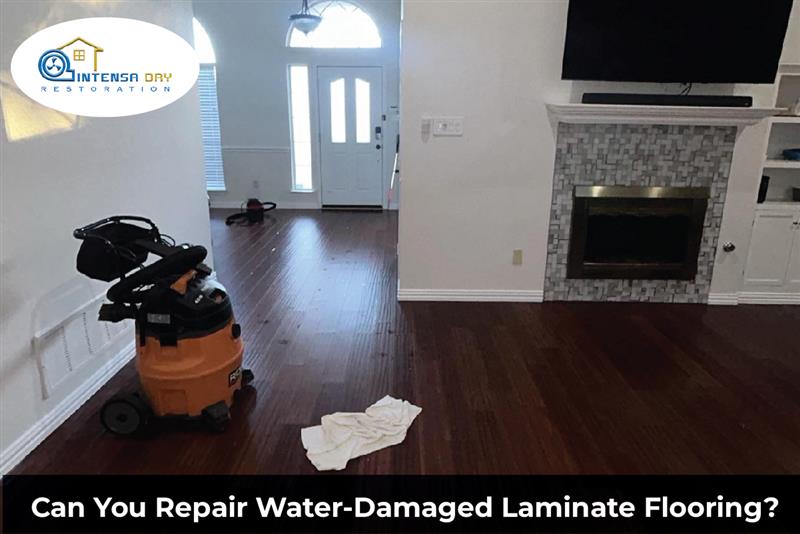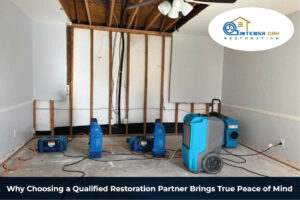How to Repair Water-Damaged Laminate Flooring | Intensa Dry
Can You Repair Water-Damaged Laminate Flooring?

Water and laminate flooring are not the best of friends. While laminate is stylish, budget-friendly, and easy to maintain under normal conditions, it can suffer greatly when exposed to excessive moisture. Whether from a leaky dishwasher, an overflowing washing machine, or a small flood, water damage can leave your once-beautiful laminate warped, swollen, and buckled. This guide will walk you through what’s possible, what’s not, and how to tackle fixing swollen laminate flooring, replacing damaged laminate panels, and restoring your floor’s look and stability. You’ll also find tips to prevent future issues so you can keep your floors in top condition for years to come.
Understanding the Nature of Water Damage in Laminate
Laminate flooring has a highly absorbent fiberboard core. Once water seeps into it, the board swells, and the damage is often irreversible. Unlike solid hardwood, laminate cannot be sanded down to remove warping. In most cases, repairing warped laminate planks means replacing them entirely. This swelling typically happens around the edges, causing the planks to lift or buckle.
Small spills that are cleaned quickly may not cause long-term harm, but standing water or unnoticed leaks are the biggest culprits. When you notice soft spots, raised seams, or buckling, it’s a sign that water has penetrated deeply enough to compromise the material.
Acting Fast: Why Timing Matters
When laminate flooring is exposed to water, every minute counts. The longer the water sits, the more the material will absorb, increasing the likelihood of permanent damage. Immediate action is your best defense.
Start by stopping the source of water. Use towels, a wet/dry vacuum, or fans to remove as much moisture as possible. Then, lift any affected planks if feasible to allow the subfloor to dry. This step not only helps reduce further damage but also gives you a better view of the problem so you can decide whether a simple repair or full replacement is needed.
Can You Repair or Should You Replace?
The answer depends on how extensive the water damage is. If only a few boards have minor swelling, you might get away with replacing those specific planks. This process works well for isolated incidents like a small leak or localized spill.
However, if the water has spread across a larger area or has been sitting for a long time, you may need a complete replacement. This is especially true if you see signs of mold or severe warping or if the underlayment is damp. In such cases, replacing damaged laminate panels ensures a safe, even, and long-lasting result.
Step-by-Step: Replacing Water-Damaged Laminate Boards
- Remove Floor Trim or Molding – Carefully pry off the baseboards to access the edges of the laminate.
- Disassemble the Planks—Laminate is usually installed as a floating floor, so planks can be unlocked from one another. Start from the nearest wall and work toward the damaged boards.
- Remove the Damaged Pieces – Lift and discard the swollen laminate floorboards and fix candidates.
- Inspect the Subfloor—Make sure it is dry, level, and mold-free before continuing.
- Install New Planks – Match the replacements in color, texture, and thickness. Let them acclimate to the room temperature for a day before installation.
- Reassemble and Seal – Lock the planks back in place and reinstall the baseboards. Consider sealing the seams with silicone in moisture-prone areas.
Common Mistakes to Avoid
One major mistake is trying to “flatten” or “dry out” a swollen plank in place. Once the fiberboard core expands, it will not shrink back to its original state. Another common error is replacing boards without thoroughly drying the subfloor. This can trap moisture underneath and lead to repeated damage.
Skipping protective measures after repairs is another oversight. If your floor has already suffered once, it’s worth adding preventative steps, like sealing seams or placing water-absorbent mats near sinks and appliances.
DIY vs. Professional Repair
DIY laminate floor repair after a water leak is possible for small, localized damage—especially if you have leftover planks from the original installation. This approach saves money and allows you to control the process.
However, for larger-scale damage or if moisture has penetrated the subfloor, calling a professional is the safer route. Professionals can ensure the entire area is dried properly, replace boards seamlessly, and address any mold concerns that could affect indoor air quality.
Preventing Future Water Damage
Water damage prevention is always more affordable and less stressful than repair. Here are some habits and measures to protect your laminate floors:
- Clean spills immediately, even small ones.
- Place protective mats near sinks, entryways, and laundry areas.
- Install water leak detectors near appliances and plumbing fixtures.
- Use proper underlayment with a moisture barrier during installation.
- Avoid wet mopping; instead, use a damp cloth or microfiber mop.
By following these steps, you’ll reduce the risk of laminate floor swelling after water exposure and keep your flooring looking fresh for years.
Fast, Reliable Laminate Repair & Prevention
While repairing water-damaged laminate flooring is possible in certain cases, the reality is that most damaged planks will need replacing. The key is acting quickly to remove moisture, identifying whether the damage is isolated or widespread, and taking steps to prevent future problems. For small issues, DIY repairs can be effective, but large-scale damage often calls for professional help. With the right approach, you can restore your floor’s beauty, maintain its durability, and protect your investment for the long term.
FAQs
1. Can I sand down swollen laminate to fix it?
No. Laminate cannot be sanded like hardwood. Swollen or warped boards must be replaced.
2. How long does it take for water to damage laminate?
Damage can begin within hours if water is left standing, so quick action is crucial.
3. Is water-resistant laminate completely waterproof?
No. Water-resistant laminate can handle minor spills but is still vulnerable to prolonged exposure.
4. Can I replace just one plank in the middle of the floor?
Yes, but it requires carefully removing surrounding planks or making a precise cut to replace the damaged piece.

